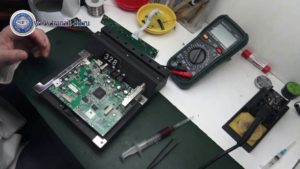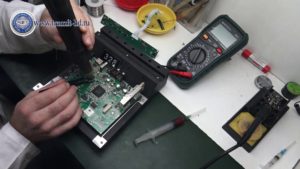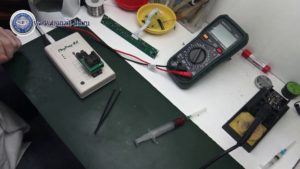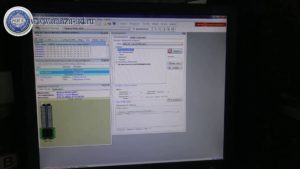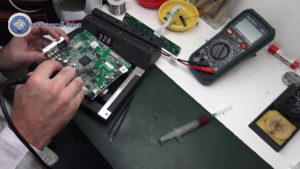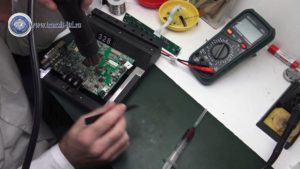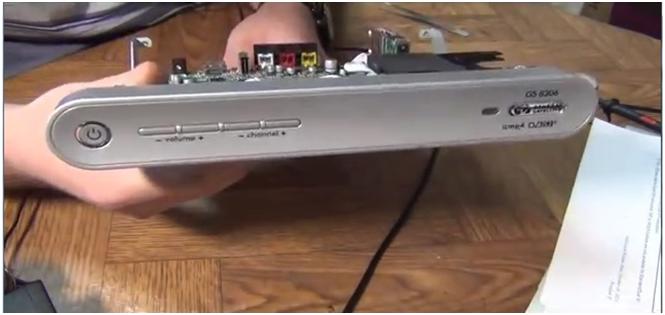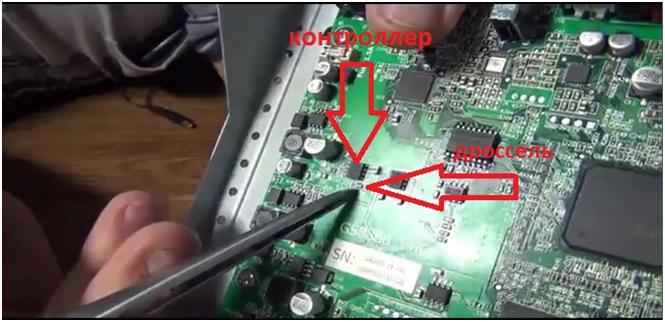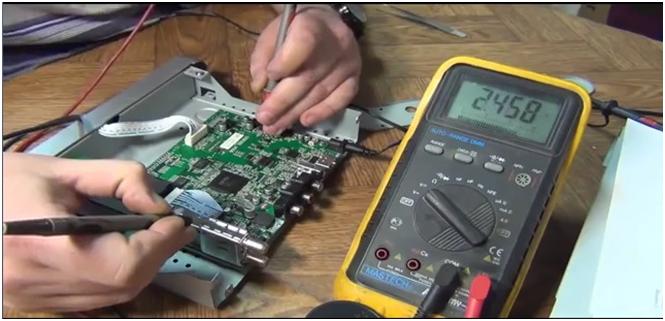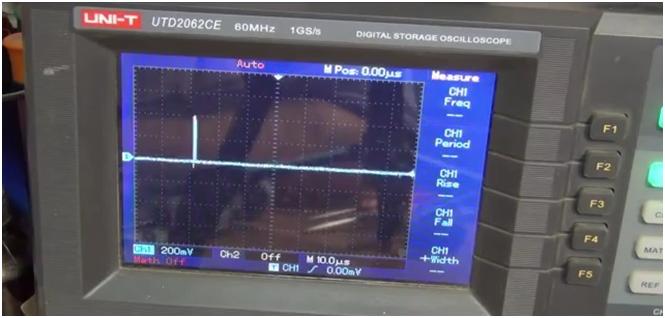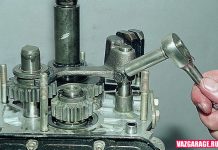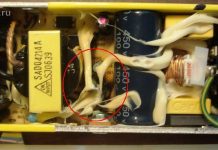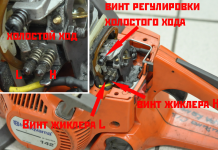If the following message appears when inserting a smart card: “Smart card is incorrect Smart card is not inserted “
, then the fastest on the receiver board is the smartcard controller TDA8024 .
We change it and rejoice
Operating voltages on the board:
Message :
If such a garbage happened and the flashing did not help, then the fastest of all is an iron problem:
In my case, the receiving module turned out to be the culprit:
And upon opening it, flooding and corrosion were found:
Plus, after removing the module, the track was damaged:
The module includes: m88ts2022 (DVB-S2 / DVB-S / ABS-S tuner) and M88DS3103 (DVB-S2 / S demodulator)
Accordingly, I had to replace the module from the donor. and throw the track MGTF - ohm.
Only the radio works (as an option), does not reset to factory settings, freezes and turns off, is not flashed via USB, is not updated in any way.
The main and most common malfunction of all receivers is a malfunction in the power supply and voltage conversion circuit. Also, the modulator often fails due to a short circuit in the coaxial cable from the LNB, although the latest models have good protection against short circuits in the cable, when triggered, the voltage supply to the converter simply stops until the short circuit is eliminated.
And so, our receiver does not show any signs of life, the indicators on the front panel display do not light up, and no twitching of the power plug from the outlet and turning on the toggle switch does not help us (at least that was the case with the device, an example of which is given in this article) ...The first thing we do is pull out the plug from the network and remove the top cover, we need to get to the electronic filling of the device. And here it is important to remember one thing, namely, about the warranty seal, which of course we will break if we remove the cover. Therefore, once again make sure that the warranty period has definitely expired, and under warranty no one will repair it for you. If the warranty is still valid, I advise you to take the receiver to a service center and entrust this matter to a specialist.
Receiver inside:
The electrolytic or oxide capacitor at the input often dries up and fails, which is also a malfunction, not everyone can find such a breakdown either, you need to have at least an initial level of a radio amateur. Usually, defective capacitors are swollen, yellowish, or have a small brown speck on the board at the base of the legs. Also, the serviceability of a capacitor can be determined by comparing its nominal and measured capacitance.
The receiver uses direct current, which is rectified from the AC mains using a diode bridge. Problems with the diode bridge also happen. It is very simple to check diodes, the main function of a semiconductor diode is to pass current in one direction, and not in the other. In my case, the transistor of the primary winding of the transformer turned out to be faulty, it is not difficult to find it, it usually has a radiator to remove heat. I determined the malfunction of the transistor by measuring the voltage at its emitter, it was absent there, the primary winding was not powered, respectively, everything else is de-energized. The transistor cost me 28.5 rubles. Replacing it with a soldering iron, I eliminated the malfunction and the receiver is back in working order. I must say such a breakdown is quite a rare occurrence, usually it all ends with a fuse.
A very common malfunction is a firmware crash. The firmware often crashes, this is usually evidenced by the complete hang of the receiver. In this case, "flashing" will help. I will say about one more reason for the malfunction, which may arise due to poor-quality installation. Water in the cable. If the outer insulation of the cable is broken, then water from atmospheric precipitation can get inside it, it easily, like a hose, gets into the receiver, sometimes flooding all of its insides. The condition of the cable must be monitored throughout the entire service life of the device.
Written by Administrator on 07 December 2011.
Hello, today we will try to fix the Tricolor TV receiver with our own hands. Many faced such a problem when the warranty (usually it is 12 months) expired, and the receiver suddenly failed. A new one is expensive, and in most cases the repair will not be difficult and will cost a penny, if you are even a little friends with a soldering iron, the main and most common faults are easy to fix yourself. Let's consider such a repair using the example of another GS-8300 N receiver from the Tricolor TV company. I must say that the device is not of the best quality, and of course, Tricolor TV is not worth the money that Tricolor TV takes for it. But, nevertheless, the number of subscribers is large and not all of them work for a long time and regularly.
The main and most common malfunction of all receivers is a malfunction in the power supply and voltage conversion circuit. Also, the modulator often fails due to a short circuit in the coaxial cable from the LNB, although the latest models have good protection against short circuits in the cable, when triggered, the voltage supply to the converter simply stops until the short circuit is eliminated.
And so, our receiver does not show any signs of life, the indicators on the front panel display do not light up, and no twitching of the power plug from the outlet and turning on the toggle switch does not help us (at least that was the case with the device, an example of which is given in this article) ... The first thing we do is pull out the plug from the network and remove the top cover, we need to get to the electronic filling of the device. And here it is important to remember one thing, namely, about the warranty seal, which of course we will break if we remove the cover.Therefore, once again make sure that the warranty period has definitely expired, and under warranty no one will repair it for you. If the warranty is still valid, I advise you to take the receiver to a service center and entrust this matter to a specialist.
The electrolytic or oxide capacitor at the input often dries up and fails, which is also a malfunction, not everyone can find such a breakdown either, you need to have at least an initial level of a radio amateur. Usually, defective capacitors have a yellowish appearance, or a small brown speck on the board at the base of the legs. Also, the serviceability of a capacitor can be determined by comparing its nominal and measured capacitance.
The receiver uses direct current, which is rectified from the AC mains using a diode bridge. Problems with the diode bridge also happen. It is very simple to check diodes, the main function of a semiconductor diode is to pass current in one direction, and not in the other. In my case, the transistor of the primary winding of the transformer turned out to be faulty, it is not difficult to find it, it usually has a radiator to remove heat. I determined the malfunction of the transistor by measuring the voltage at its emitter, it was absent there, the primary winding was not powered, respectively, everything else is de-energized. The transistor cost me 28.5 rubles. Replacing it with a soldering iron, I eliminated the malfunction and the receiver is back in working order. I must say such a breakdown is quite a rare occurrence, usually it all ends with a fuse.
A very common malfunction is a firmware crash. The firmware often crashes, this is usually evidenced by the complete hang of the receiver. In this case, "flashing" will help. I also want to say about another cause of the malfunction, which may arise due to poor-quality installation. Water in the cable. If the outer insulation of the cable is broken, then water from atmospheric precipitation can get inside and it easily enters the receiver like a hose, sometimes flooding all of its insides. The condition of the cable must be monitored throughout the entire service life of the device.
Electronic devices surround us everywhere: on the street, at work, at home. With the rapid growth and availability of satellite television to the general public, a wide range of satellite equipment has emerged for the general public. These are satellite receivers, conditional access modules, antennas, converters, etc. Whether we like it or not, sooner or later breakdowns occur with them, which cause us to feel the loss of our beloved thing.
You should not despair - for this there are service centers that you can turn to and they will help you to bring your equipment back to life.
Breakdowns of equipment occur for various reasons - voltage drops, failure of various nodes, wear and tear of the equipment itself from its venerable age, you can also note the incompetence of the owners themselves, for example, improper replacement of software in satellite and cable receivers.
Power supply failure is perhaps the most common type of digital terminal failure. It arises for various reasons: a poor-quality supply network (see photo), poor-quality radio components were used, especially this is de facto in Chinese technology.
Also, this can include violation of operation, dust, dirt, as a result of this, the thermal regime is not correct (see photo).
A service center is a structural unit within a company. He is responsible not only for the repair and maintenance of the products sold by our company, but also for the repair (including warranty) of satellite equipment from other companies. Our clients are not only individuals - users, but also equipment dealers who seek to save their customers from the problems associated with the repair and maintenance of receivers.Our flexible corporate customer policy allows us to provide adequate service and meet the interests of all customer groups. This is more than 1000 units of equipment per month. To carry out such large volumes, of course, allows the professionalism of the staff, the equipment of the service center with professional equipment, tools and technical documentation. Therefore, in our service center we carry out high-complexity repairs: for example, replacing processors in BGA cases. Repair takes place in the shortest possible time.
The supply department, in addition to its main function - the purchase of equipment, is also engaged in meeting the needs of the service center, purchasing components necessary for repair. And here it is worth noting that the selection and purchase of components for repair is carried out according to the following criterion: the quality of parts comes first, their price comes second, but due to the large volumes of supplies of parts, the price ultimately remains low.
Of course, unforeseen moments happen - for some reason, the repair is delayed. This usually happens due to the lack of some scarce radio component. Sometimes repairs require a complete replacement of the motherboard, and this repair part is not always available. In this case, we are trying to find some acceptable solution together with the client, taking into account his wishes, combined with our capabilities.
At autopsy, found out of order:
According to the table on identification and selection of analogs https://my.housecope.com/wp-content/uploads/ext/2561/ic_power/, the last part was replaced with SG6848 with minimal interference with the factory circuit.
SSS4N60B (TO-220F package) was installed instead of the burnt-out Q1
On Telesputnik posted a diagram of the power supply unit.
The receiver turns on, the LNB has 18 volts. There is no video signal, it gets very hot (the finger does not hold) stv 6419 .. because of it there can be no video? there is no other point? (in the sense that more video signal is not to be taken from?) the receiver switches channels ..
GS 8300N receiver there is no video and audio signal through scart to the TV, the channels are switched on the receiver panel.
the video signal from the STi5119ALC chip can be checked with an oscilloscope at the control point opposite the capacitor C117, then it comes to the resistor R87 and is transmitted to the capacitor C129 and then goes to the STV6419 microcircuit from it there is no output to R91, the culprit is not 12 volts on the board, respectively, there is no power + 12V on the 3rd leg STV6419, a 12 volt Zener diode D3 is faulty near the power connector
There was such an answer: if you use only composite video signal, most likely it can be simply thrown out (replaced with a jumper). And where to put the jumper? if that's the right advice ..
Defective VD3 (VD3 zener diode 12 V) on the motherboard next to the power connector.
Zener diode brand and parameters:
Power supply + 12V for 3rd leg STV6419.
Zener diode analog:
VD3 STV6419 similar Zener diode (SMD) did not find. Put a 0.5 watt glass zener diode the size of a diode kd522 ... While the flight is normal.
If replacing the zener diode did not help:
After the thunderstorm, 6419 swelled. After the replacement, the image did not appear, but when checking the strapping, two resistors were cut off, R91, R95 ... I replaced it, and it worked.
One more problem:
And yet, instead of 13, 18 Volts, 24V was running on the LNB. Replacement required DA1 (LM317T) ... And that's it, the flight is normal
The same situation with the GS-8304 receiver:
After 5 years of operation, the GS-8304 suddenly stopped broadcasting, although the indication is working properly. Zener diode brand MMZE5242B.
Access module Tricolor CAM CI + with access card for 5050 rubles.
Tricolor TV gives you 180 days of viewing the "United" package!
Firmware SPI Flash W25Q128BVFG receiver GS 8306
This article is devoted to restoring the performance of the GS 8306 / GS 8305 satellite receiver intended for viewing the channels of the satellite operator Tricolor TV.
Earlier we published two articles on the topics: "Operating modes of the GS 8306 receiver"; "Updating GS 8306 firmware", however, as practice has shown, not all methods described in these articles brought the receiver to work.
We regularly receive questions about returning the receiver to working condition with the following symptom:
The cause of this condition, with a high probability, is the "flying" firmware GS 8306 Tricolor , as a result of which the GS 8306 receiver does not turn on. Automatic firmware GS 8306 Tricolor from an external USB drive, in most cases, does not lead to success.
The way out of this situation is the SPI Flash W25Q128BVFG firmware, which is located on the motherboard of the GS 8306 satellite receiver.
To carry out repair GS 8306 Tricolor You will need to have an IC programmer and a soldering station available. Without these devices, it makes no sense to start work on restoring the operability of the receiving equipment. If all of the above devices are at hand and you know how to handle them, then you can start repair GS 8306 Tricolor .
The first step is to provide access to the GS 8306 motherboard, which contains the SPI Flash W25Q128BVFG chip required for firmware. To do this, we disassemble the GS 8306 receiver body by tightening the screws and nuts located on the back and bottom panels.
By unscrewing the screws, you can remove the rear panel and the top cover of the GS 8306 digital set-top box. Access to the motherboard is immediately opened.
The board itself does not need to be unscrewed from the base of the receiver body, since it will in no way interfere with the removal of the SPI Flash W25Q128BVFG chip from the board.
The next step in the recovery will be the desoldering of the microcircuit, for which we warm up the soldering points of the microcircuit legs to the contact tracks of the board with a soldering hairdryer. After sufficient warming up, the microcircuit is removed from the board without much effort.
Further, through the adapter using the programmer, you need to load the working dump into the microcircuit firmware GS 8306 Tricolor : 1.1.001 or 1.2.001, (dump firmware GS 8307 Tricolor : 1.0.015) at the same time we are convinced of the operability of the microcircuit itself, otherwise we replace it.
After firmware GS 8306 Tricolor will be poured into the microcircuit, it is necessary, observing the labels on the microcircuit and the key on the motherboard, to solder the chip into place, visually making sure that all the legs of the microcircuit are in contact with the contact tracks.
Before assembling the GS 8306 receiver, let's make sure it works, for which we connect the satellite dish, power supply and audio-video cable to the appropriate connectors. If the firmware was successful and we did everything correctly, then the GS 8306 receiver menu sections will appear on the TV screen.
In the “status” menu of the receiver, we clarify whether the firmware version of the receiver corresponds to the latest current version (at the time of publication of the article on 07/19/2016, the current firmware version is 1.2.001). If the firmware version is different, download the latest firmware version from official sources and, using an external USB drive, update the receiver. How to do this can be found in our article "Updating GS 8306 Firmware". Go to the "status" menu again and check that the firmware version has been updated to the latest.
Subsequently, you can assemble the receiver and enjoy watching your favorite TV channels.
P.S. After the launch of updates in automatic mode for receivers GS 8306 (8305) and GS 8307 (8308) in September 2016. from the satellite, we began to receive a lot of questions about bringing the GS 8306 and GS 8307 receivers into working order, which did not complete all the stages of the firmware update, as a result of which the receivers did not load.
To restore the receiver's performance, it is necessary to flash the SPI Flash W25Q128BVFG microcircuits in the GS 8306 receiver or the SPI Flash W25Q256FVFG in the GS 8307 receiver with a working version of the sewing according to the same scheme.
After restoring the firmware, or replacing a microcircuit with a working firmware, we are looking for an alternative firmware on the network, version 1.2.21789 for GS 8306 or 1.0.21789 for GS 8307 (in which auto-update from satellite is disabled) and install it from a USB flash drive.
If you do not have a programmer or soldering station at your disposal, make repair GS 8306 Tricolor and GS 8307 you can contact our company at Kirov, Solnechny proezd, 8, t. 44-13-50 .
You can also order a SPI Flash W25Q128BVFG chip with firmware for GS 8306 from us, or a W25Q256FVFG chip with firmware for GS 8307, which you yourself, or contact any workshop, replace it on your receiver.
The main and most common malfunction of all receivers is a malfunction in the power supply and voltage conversion circuit. Also, the modulator often fails due to a short circuit in the coaxial cable from the LNB, although the latest models have good protection against short circuits in the cable, when triggered, the voltage supply to the converter simply stops until the short circuit is eliminated.
And so, our receiver does not show any signs of life, the indicators on the front panel display do not light up, and no twitching of the power plug from the outlet and turning on the toggle switch does not help us (at least that was the case with the device, an example of which is given in this article) ... The first thing we do is pull out the plug from the network and remove the top cover, we need to get to the electronic filling of the device. And here it is important to remember one thing, namely, about the warranty seal, which of course we will break if we remove the cover. Therefore, once again make sure that the warranty period has definitely expired, and under warranty no one will repair it for you. If the warranty is still valid, I advise you to take the receiver to a service center and entrust this matter to a specialist.
Receiver inside:
The electrolytic or oxide capacitor at the input often dries up and fails, which is also a malfunction, not everyone can find such a breakdown either, you need to have at least an initial level of a radio amateur. Usually, defective capacitors are swollen, yellowish, or have a small brown speck on the board at the base of the legs. Also, the serviceability of a capacitor can be determined by comparing its nominal and measured capacitance.
The receiver uses direct current, which is rectified from the AC mains using a diode bridge. Problems with the diode bridge also happen. It is very simple to check diodes, the main function of a semiconductor diode is to pass current in one direction, and not in the other. In my case, the transistor of the primary winding of the transformer turned out to be faulty, it is not difficult to find it, it usually has a radiator to remove heat.I determined the malfunction of the transistor by measuring the voltage at its emitter, it was absent there, the primary winding was not powered, respectively, everything else is de-energized. The transistor cost me 28.5 rubles. Replacing it with a soldering iron, I eliminated the malfunction and the receiver is back in working order. I must say such a breakdown is quite a rare occurrence, usually it all ends with a fuse.
A very common malfunction is a firmware crash. The firmware often crashes, this is usually evidenced by the complete hang of the receiver. In this case, "flashing" will help. I will say about one more reason for the malfunction, which may arise due to poor-quality installation. Water in the cable. If the outer insulation of the cable is broken, then water from atmospheric precipitation can get inside it, it easily, like a hose, gets into the receiver, sometimes flooding all of its insides. The condition of the cable must be monitored throughout the entire service life of the device.
VIDEO
flashing satellite receiver GS 8305 after unsuccessful firmware update via satellite. The video describes an example of how to flash a USB stick of a satellite receiver after an unsuccessful software update through the provider. In other words, a forced downgrade (downgrade, to the previous version) of the firmware is carried out.
LCD TV power supply repair
GS B521 Let's disassemble our copy and see what this receiver has.
Video (click to play).
Tricolor receiver GS E501 Is it worth taking? It's up to you to decide.

